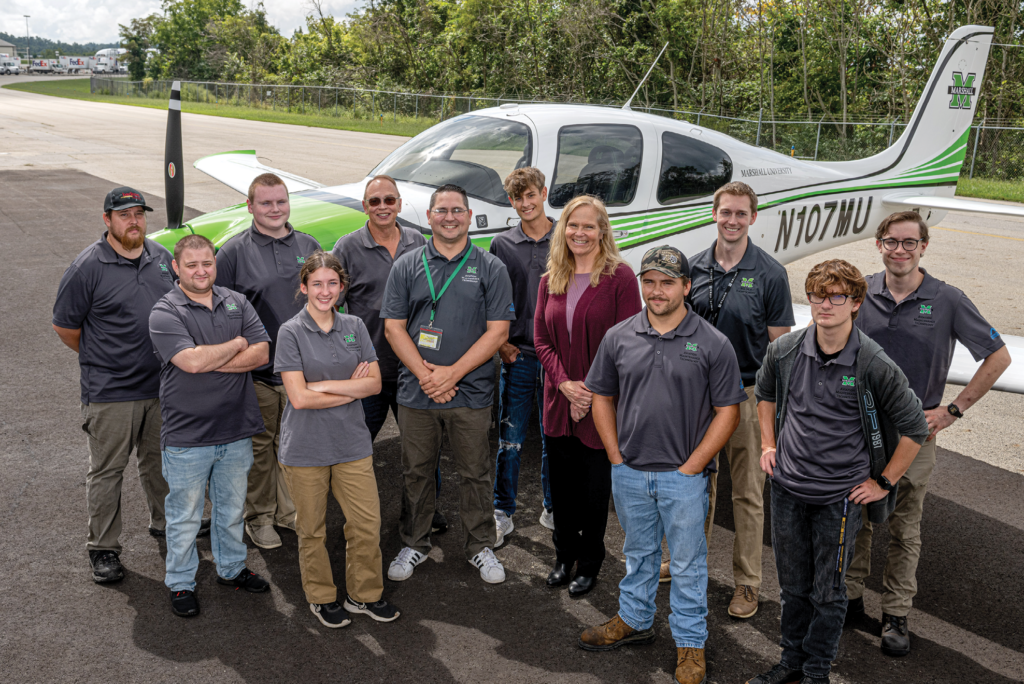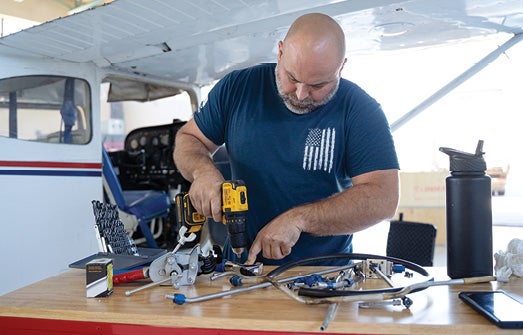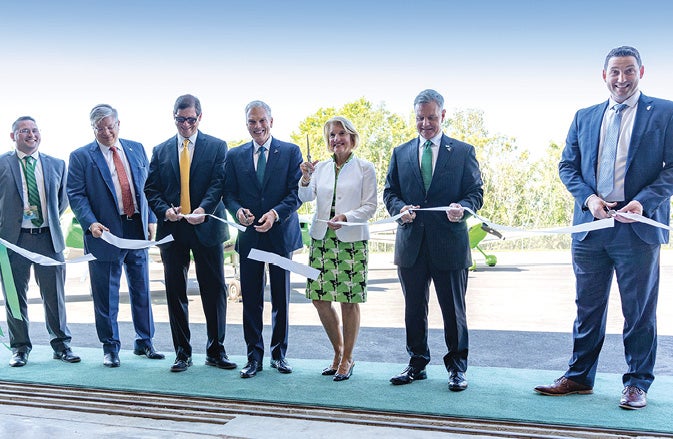The opening of the Aviation Maintenance Technology program in Huntington has Marshall poised to fill some of the most in-demand jobs in the world.
 Bill Noe says Marshall University is perfectly poised to bolster the aviation industry for decades to come.
Bill Noe says Marshall University is perfectly poised to bolster the aviation industry for decades to come.
“If you’ve ever watched somebody surf, you see them sitting out there waiting for the perfect wave to ride,” said Noe, the university’s new chief aviation officer and the man for whom its flight school in Charleston is named. “At Marshall we see this perfect wave starting to come our way, and we’re starting to paddle hard to catch it because we know we will be able to ride it for the next 30-plus years.”
Noe, an accomplished pilot and the former president and chief operations officer for NetJets, the largest private jet fleet in the world, has served as a trusted adviser to Marshall’s aviation program since its inception in 2017. He was tapped to lead it in late August 2022, and it seems the sky’s the limit for his vision.
“Right now, the aviation industry is so open that you can pick and choose pretty much what you want to do once you get your certifications and qualifications,” Noe said. “We have aircraft manufacturers right now telling us they want to hire people coming out of our program. We have them wanting to support our program financially and donate equipment to help us train people they can hire. They — all the major players — are donating engines, wings, propellers and more to help expose our students to everything they need to know.”
In Noe’s eyes, Marshall’s Division of Aviation, which operates two programs through agreements with West Virginia International Yeager Airport in Charleston and Tri-State Airport in Huntington, is perfectly positioned for the future. He said he envisions the aviation division evolving into an industry leader that produces capable, adaptable, industry-savvy professionals, including pilots from the Bill Noe Flight School and administrators from the aviation management program in the Lewis College of Business. And now, students are being trained in the critical field of aviation maintenance technology through a partnership with Mountwest Community and Technical College, which became the nation’s newest FAA-approved aviation maintenance technician school and the first of its kind in the region.
There’s no doubt aviation is gaining speed at Marshall. Noe’s intention is to feed the program well and watch it get stronger and stronger, he said.
 “I’m asked, ‘Bill, can you train your students this way, or that way,’ and it makes me think of the scene in the movie Jaws where someone says, ‘We’re gonna need a bigger boat.’ Once we get up to full throttle with Marshall aviation, we may need a bigger school,” Noe laughed.
“I’m asked, ‘Bill, can you train your students this way, or that way,’ and it makes me think of the scene in the movie Jaws where someone says, ‘We’re gonna need a bigger boat.’ Once we get up to full throttle with Marshall aviation, we may need a bigger school,” Noe laughed.
James Smith directs the Aviation Maintenance Technology program and said many stars had to align to get it up and running in time for classes that began in August. Years of work culminated in a flurry of activity prior to the start of the fall semester. FAA certification was granted in late June. An open house was held in early July. Twenty qualified students were recruited and admitted to the program, beginning classes even before the ribbon was cut on the state-of-the-art training facility at Huntington Tri-State Airport.
Certainly, Smith’s program will fill a void in the aviation industry; but he said he also sees potential for it to serve as an economic driver for the region, producing a workforce with malleable skills that also directly answers industry needs.
“One-quarter of students who graduate from these programs will go to work in oil and gas, maritime and automotive industries,” Smith said. “So, the Aviation Maintenance Technology program is a blessing for all the industries in the region.”
Students will earn an Associate of Applied Science (A.A.S.) through an 18-month, year-round program. Graduates will be qualified to take the FAA’s Airframe and Powerplant certification exams, which are good for life and can be used in any state without restriction. The average U.S. annual salary for an aviation technician? Over $55,000. Industry need for AMTs? 132,000 technicians before 2041. Current licensed AMTs? Not enough to fill every job. Coming attrition? 30% of the existing AMT workforce will retire, creating thousands of positions for new technicians. These are not great statistics for the industry, but they are great for students. Smith is seeking perfect candidates for 2023 to fill 30 spaces for the spring semester and 50 for the fall semester. The FAA sets the ratio of instructors to students at 25:1 to ensure quality instruction.
 “The aviation industry is hurting for technicians; and if you look at the way a lot of companies invest in their infrastructure, they tend to invest in facilities where they have a direct pipeline of workforce,” Smith said. “My goal for the Aviation Maintenance Technology program is to inspire companies to come to Huntington that can employ our students and help grow our airport.”
“The aviation industry is hurting for technicians; and if you look at the way a lot of companies invest in their infrastructure, they tend to invest in facilities where they have a direct pipeline of workforce,” Smith said. “My goal for the Aviation Maintenance Technology program is to inspire companies to come to Huntington that can employ our students and help grow our airport.”
Overall, Marshall’s aviation program has received a number of gifts from the likes of Delta Airlines TechOps and the Embraer Foundation, among others, in support of its nascent program; and at least one company, Thoroughbred Aviation, has expanded to Huntington Tri-State Airport in part due to Marshall’s program. Monica Newman McCluney, head of the Embraer Foundation, said, “Aviation is a robust, high-growth industry; and the incoming students at Marshall University have the opportunity to greatly contribute to the future of flight. We celebrate the university, as well as the students, and are proud to be part of this journey.”
There’s no need for instruments to gauge what those kinds of strong industry investments mean for Marshall’s climb in the world of aviation. It’s ultimately about jobs for students — whether they operate, build or maintain aircraft or manage those who do. Curating a specialized workforce takes time. As Noe says, “You do have to crawl before you walk.”
Noe’s most meaningful involvement in the program begins as students are preparing to leave it. He wants his students to have jobs before they graduate, he said.
“That’s when I go to work creating paths to guaranteed employment, guaranteed opportunity, guaranteed fulfillment for our students just about anywhere they want to go. That’s what we are starting to see happen already with these aviation companies,” Noe said.
————
About the author: Lalena Price is a freelance writer living in Kenna, West Virginia.
Photos (from top):
The first students of the Aviation Maintenance Technology A.A.S. program at Marshall University are joined by James Smith, program drector, and Nancy Ritter, director of the Bill Noe Flight School.
Students are being trained in the critical field of aviation maintenance technology through a partnership with Mountwest Community and Technical College.
From left, AMT Program Director Jim Smith; Stephen M. Friedrich, CCO, Embraer Executive Jets; William Smith, Director, Learning and Development, Delta Air Lines; MU President Brad D. Smith; Sen. Shelley Moore Capito; MU Chief Aviation Officer Bill Noe; and Mountwest Community and Technical College President Joshua Baker cut the ribbon on the new Aviation Maintenance Technology (AMT) program’s facility at Huntington Tri-State Airport Aug. 25.